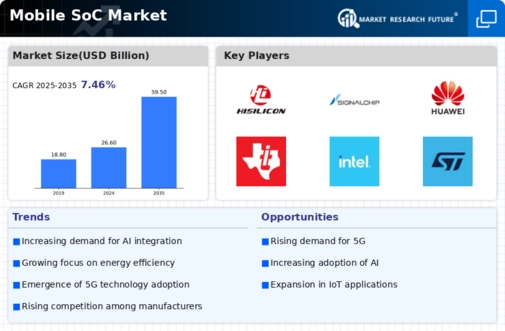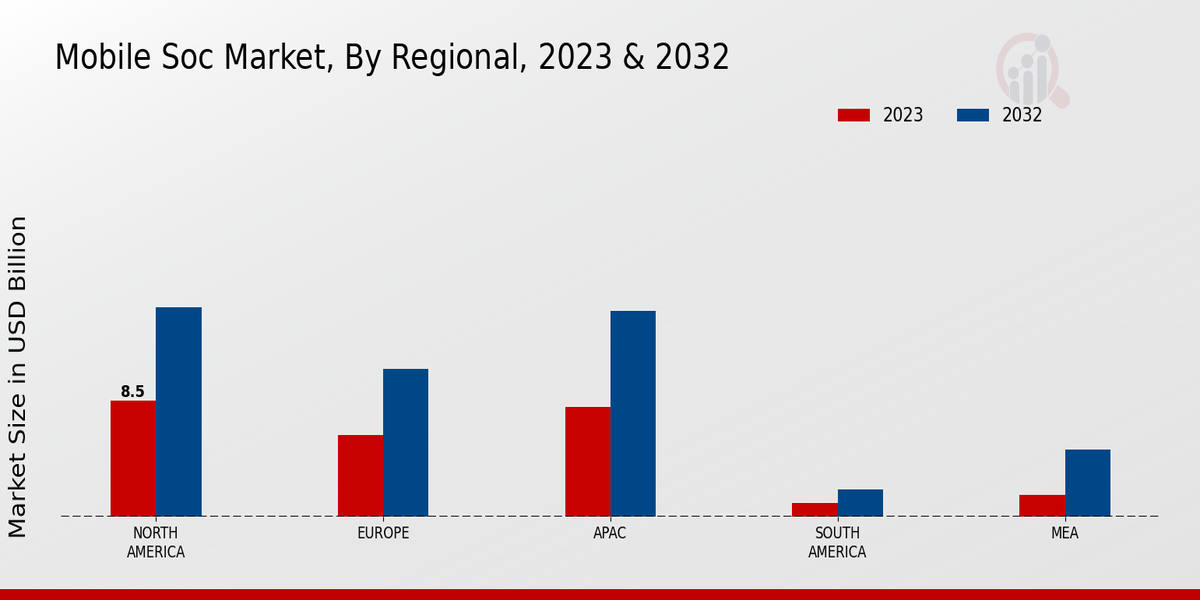Market Growth Projections
The Global Mobile SoC Market Industry is projected to experience substantial growth in the coming years. With a market valuation of 26.6 USD Billion in 2024, the industry is expected to reach 59.5 USD Billion by 2035, reflecting a robust growth trajectory. The anticipated CAGR of 7.61% from 2025 to 2035 indicates a strong demand for mobile SoCs driven by technological advancements and increasing consumer adoption of mobile devices. This growth is likely to be fueled by the integration of emerging technologies such as AI and 5G, which are reshaping the mobile landscape. As a result, stakeholders are encouraged to invest in innovative SoC solutions to capitalize on this expanding market.
Emergence of 5G Technology
The emergence of 5G technology is poised to transform the Global Mobile SoC Market Industry significantly. With its promise of ultra-fast data speeds and low latency, 5G is driving the demand for advanced SoCs capable of supporting these capabilities. Manufacturers are increasingly investing in the development of SoCs that can leverage 5G networks, enabling enhanced mobile experiences such as augmented reality and high-definition streaming. This shift is expected to catalyze market growth, as consumers and businesses alike seek devices that can fully utilize 5G technology. The anticipated market expansion underscores the importance of 5G-ready SoCs in the evolving mobile landscape.
Rising Demand for Mobile Devices
The increasing global demand for mobile devices is a primary driver of the Global Mobile SoC Market Industry. As of 2024, the market is valued at approximately 26.6 USD Billion, reflecting a robust consumer inclination towards smartphones, tablets, and wearables. This trend is further fueled by advancements in mobile technology, which enhance user experiences through improved performance and efficiency. The proliferation of mobile applications across various sectors, including gaming, education, and healthcare, necessitates powerful SoCs that can support complex functionalities. Consequently, manufacturers are compelled to innovate and optimize their SoC offerings to meet the evolving needs of consumers.
Growth of Internet of Things (IoT)
The rapid expansion of the Internet of Things (IoT) is significantly influencing the Global Mobile SoC Market Industry. As more devices become interconnected, the demand for efficient and powerful SoCs that can handle diverse applications is surging. IoT devices, ranging from smart home appliances to industrial sensors, require specialized SoCs that can process data in real-time while maintaining low power consumption. This trend is expected to contribute to the market's growth, with projections indicating a market value of 59.5 USD Billion by 2035. The integration of IoT functionalities into mobile devices further emphasizes the need for advanced SoC solutions.
Increased Focus on Energy Efficiency
The growing emphasis on energy efficiency in mobile devices is a significant driver of the Global Mobile SoC Market Industry. Consumers are increasingly aware of the environmental impact of their devices, leading to a demand for SoCs that optimize power consumption without compromising performance. Manufacturers are responding by developing energy-efficient SoCs that utilize advanced technologies such as dynamic voltage scaling and multi-core architectures. This focus on sustainability not only appeals to environmentally conscious consumers but also aligns with global initiatives aimed at reducing carbon footprints. As a result, the market is likely to experience sustained growth as energy-efficient solutions become a standard expectation.
Technological Advancements in SoC Design
Technological advancements in SoC design play a crucial role in propelling the Global Mobile SoC Market Industry. Innovations such as 5G integration, AI capabilities, and enhanced power efficiency are becoming increasingly prevalent in modern SoCs. These advancements not only improve device performance but also extend battery life, which is a significant concern for consumers. As manufacturers strive to incorporate cutting-edge technologies, the market is expected to witness substantial growth. The anticipated CAGR of 7.61% from 2025 to 2035 indicates a strong trajectory for the industry, driven by continuous improvements in SoC architectures and fabrication processes.
























Leave a Comment